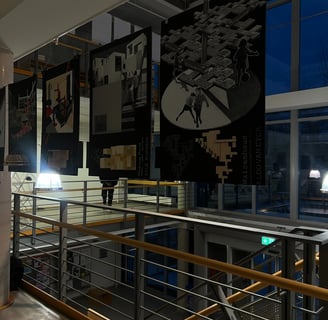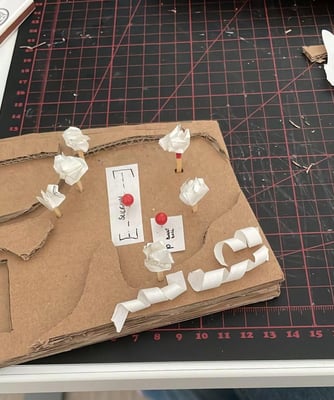Mastering Your Concept: A Guide to Creating a Unique Architecture Semester Project
I know the frustration of spending weeks without any new ideas while watching other students already making progress. It can feel disheartening to be stuck, but trust me, it happens to everyone. That’s why I’m here to share my tips on breaking through creative blocks and finding a strong concept for your project that will truly impress your professor.
ARCHITECTURE
Sofia
11/16/20245 min read


1. Site Analysis
The first thing you should do when starting a new project is to analyze the site. Find out everything you can—trust me, it will be useful later. Some aspects you might want to analyze include:
Connection to Public Transportation: How well-connected is the location to public transportation? Is it reachable by subway, train, or bus? Think about how your project's accessibility can be impacted by the walking distance to the closest stations or stops.
Who are the neighborhood's residents? How old are the residents on average? Are they primarily professionals, students, or families? This may have an impact on the design elements you incorporate, including parking, common areas, or adjacent facilities.
Climate: How would you describe the local weather? Does it rain, snow, or wind a lot? Does it become really hot or cold? Understanding how natural light will interact with your structure throughout the year can be achieved by drawing a sun path diagram. Additionally, take into account how the climate may impact the requirements for insulation and ventilation.
Local Identity: What is the reputation of the city or neighborhood? Are there any cultural or historical sites in the area? Making sure your project blends in with its surroundings can be achieved by using materials and design language that are informed by the local identity.
Accessibility: How easy is it for cars, bikes, and pedestrians to get to the location? Are there any obstacles that could make it difficult to navigate about the property, including busy highways, steep slopes, or a lack of sidewalks?
Noise Pollution: Examine the local noise levels. Is the location close to an airport, a railroad track, or a busy street? This will have an impact on how you design the building's acoustics, including whether to use soundproofing or create a structure that reduces noise intrusion.
Topography and Vegetation: Recognize the site's actual topography. Does the design need to incorporate or protect any slopes, water features, or trees? These organic elements, like trees for shade or water for aesthetics, can enhance your project's aesthetic and functionality.
These are a few of the most crucial elements on which to build your idea. Your design may adapt to the local climate or work to increase community accessibility. Environmental factors like wind or sun trajectories might affect the overall layout, and the site's history or identity may influence your aesthetic choices, depending on the assignment. These broad ideas can assist you in developing a project proposal that is well-rounded.


2. History
When researching the history of the city, consider the following points:
Historical Building Period: Did most of the city's buildings get built during a specific time period? Determining the area's architectural identity can be helped by knowing when construction activity peaked.
Dominance of Architecture: Which architectural style predominated during the time? Was it Modernist, Baroque, or another style? What are the main elements of this style, including the forms, materials, and spatial arrangement?
Including Historical Elements: To create a visual link between your project and the city's historical fabric, you could incorporate arches, columns, or windows that are typical of that era's design. The contextual significance of the project can be enhanced by including regional building materials or design elements.
Natural catastrophes: Throughout its history, has the city seen a lot of natural catastrophes, such as earthquakes, floods, or wildfires? If yes, how has the city previously responded to these difficulties? You can find resilient, disaster-proof design solutions for your project by researching the effects of previous disasters.
Cultural Changes: Examine important historical occurrences that may have influenced the city's development, architecture, and culture, such as wars, revolutions, or industrial booms. What effects did these events have on the built environment and urban fabric?
This research will not only inform your design process but will also help you create a project that respects and reflects the city’s unique identity and heritage.


4.Environment
Making your concept ecologically friendly is one of the most significant things you can do during the design process. The world can be shaped by architecture, and using sustainable practices will benefit your project's long-term worth as well as the environment. To make your project more environmentally responsible, consider the following ideas:
Sustainable Materials: Make use of materials that are long-lasting, non-toxic, and have little effect on the environment. Consider utilizing natural or recyclable materials, including clay, bamboo, or repurposed wood. Compared to traditional materials, these materials not only survive longer but also have a lower carbon footprint.
Alternative Building Techniques: Research environmentally friendly and energy-efficient building techniques include earthbag construction, straw bale construction, and rammed earth. These methods can produce distinctive and creative outcomes that elevate your design.
Energy Efficiency: Optimize natural light and ventilation in your design to save energy. As a result, less artificial heating and lighting is required. Additionally, to control interior temperatures without using heating or air conditioning equipment, think about implementing passive design techniques like thermal mass or thick walls.
Renewable Energy Sources: To capture renewable energy, include solar panels, wind turbines, or geothermal systems in your design. As you design the roof or façade to optimize solar gain, this may even have an impact on the orientation and geometry of your structure.
Water Conservation: To lessen water runoff and encourage water conservation, use rainwater harvesting devices or create permeable surfaces. Rooftop gardens and green roofs are excellent methods to control rainwater and enhance insulation and air quality.
Green Spaces: Including green areas in your design, such parks, gardens, or living walls, can increase biodiversity and make the room cozier and healthier.
I hope that these steps helped you come up with a strong idea for your architectural project. Whether it's site analysis, exploring the city's past, or taking environmental factors into account, these are the techniques I personally use when starting any new design. The outcome of your project can be significantly impacted by taking the time to carefully examine these areas, which will also assist you in creating a concept that is both original and closely related to its setting. Good luck on your upcoming project, and keep in mind that great design starts with a solid concept!


3.Find Inspiration
The professors at my university all have the same reaction when confronted with my Pinterest boards—they don't know it and often recommend other sources of inspiration. While I love Pinterest, it’s important to realize there are many other fantastic sites out there that can offer even more valuable insights. Some of my favorites include:
ArchDaily – One of the largest and most visited architecture websites, offering detailed project analyses, news, and design inspiration.
Dezeen – A go-to site for the latest trends in architecture, design, and technology. It features cutting-edge projects and the stories behind them.
Designboom – Another great source for architecture and design news, offering inspiration and project features from around the world.
Contemporist – A fantastic website that showcases contemporary architecture, design trends, and innovative projects.
The Architect’s Journal – Offers industry news, project features, and inspiration, helping architects stay connected to the latest developments.
These sites are filled with high-quality content that will provide you with a deeper understanding of current trends, innovative designs, and architectural history. So next time you're looking for inspiration, explore beyond Pinterest for a more well-rounded perspective!
